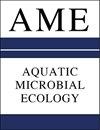赤岛异西格玛有害藻华期间的细菌群落动态
IF 1.1
4区 环境科学与生态学
Q3 ECOLOGY
引用次数: 10
摘要
浮游植物水华事件导致水生生态系统内营养成分和可利用性以及物理条件的明显变化,从而对细菌群落产生重大影响。采用元条形码方法,研究了南非星期天河口一次有害藻华(heterossigma akashiwo)对河口生态系统细菌群落结构的影响。在本研究中,在富氧地表水和低氧底水中都出现了细菌谱系,这反映了在广泛的细菌系统发育谱系中呼吸灵活性和有氧和无氧代谢的潜力。细菌群落特征与水华的生理状态密切相关,黄杆菌在赤潮期间的相对丰度增加。黄杆菌在与藻华相关的文献中经常被报道,这表明它们在藻类衍生有机物降解中的核心作用。花期以Halieaceae为主,而Synechococcales、Cryomorphaceae和Sporichthyaceae与H. akashhiwo花期的腐烂呈显著正相关。红杆菌科与赤石花呈极显著相关;然而,与文献报道的红杆菌科特有的开花相关属(主要是玫瑰杆菌)不同,本研究中高达74%的红杆菌科序列读取被分配到Litorimicrobium属。在整个赤岛H.赤潮中记录的独特细菌群落概况可归因于形成华花的物种的影响以及文献中河口发生的赤潮的代表性不足。本文章由计算机程序翻译,如有差异,请以英文原文为准。
Bacterial community dynamics during a harmful algal bloom of Heterosigma akashiwo
Phytoplankton bloom events result in distinct changes in the composition and availability of nutrients as well as physical conditions within aquatic ecosystems, resulting in significant effects on bacterial communities. Using a metabarcoding approach, this study investigated the effect of a harmful algal bloom (HAB) of Heterosigma akashiwo in the Sundays Estuary, South Africa, on bacterial community structures in this estuarine ecosystem over an entire bloom event. The occurrence of bacterial lineages occurring in both the oxygen-rich surface water and hypoxic bottom waters in this study reflects the respiratory flexibility and potential for both aerobic and anaerobic metabolism across a wide range of bacterial phylogenetic lineages. A close correlation between the bacterial community profiles and the physiological state of the bloom was observed, with Flavobacteria found in increased relative abundances during the H. akashiwo HAB. Flavobacteria are commonly reported in the literature associated with algal blooms, which is indicative of their central role in the degradation of algal-derived organic matter. Halieaceae were prevalent during the bloom, whilst Synechococcales, Cryomorphaceae and Sporichthyaceae were found to be positively correlated with the decay of the H. akashiwo bloom. Rhodobacteraceae correlated significantly with the H. akashiwo bloom; however, unlike the Rhodobacteraceae specific bloom-associated genera reported in literature (predominantly Roseobacter), up to 74% of the Rhodobacteraceae sequence reads in this study were assigned to the genus Litorimicrobium. The distinct bacterial community profiles recorded throughout the H. akashiwo HAB can be attributed to the influence of the bloom-forming species as well as under-representation of estuarine-occurring HABs in the literature.
求助全文
通过发布文献求助,成功后即可免费获取论文全文。
去求助
来源期刊

Aquatic Microbial Ecology
环境科学-海洋与淡水生物学
CiteScore
3.30
自引率
0.00%
发文量
8
审稿时长
3.0 months
期刊介绍:
AME is international and interdisciplinary. It presents rigorously refereed and carefully selected Research Articles, Reviews and Notes, as well as Comments/Reply Comments (for details see AME 27:209), Opinion Pieces (previously called ''As I See It'') and AME Specials. For details consult the Guidelines for Authors. Papers may be concerned with:
Tolerances and responses of microorganisms to variations in abiotic and biotic components of their environment; microbial life under extreme environmental conditions (climate, temperature, pressure, osmolarity, redox, etc.).
Role of aquatic microorganisms in the production, transformation and decomposition of organic matter; flow patterns of energy and matter as these pass through microorganisms; population dynamics; trophic interrelationships; modelling, both theoretical and via computer simulation, of individual microorganisms and microbial populations; biodiversity.
Absorption and transformation of inorganic material; synthesis and transformation of organic material (autotrophic and heterotrophic); non-genetic and genetic adaptation; behaviour; molecular microbial ecology; symbioses.
 求助内容:
求助内容: 应助结果提醒方式:
应助结果提醒方式:


